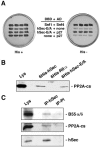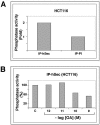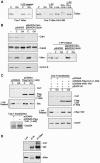Protein phosphatase 2A stabilizes human securin, whose phosphorylated forms are degraded via the SCF ubiquitin ligase
- PMID: 16705156
- PMCID: PMC1489102
- DOI: 10.1128/MCB.01904-05
Protein phosphatase 2A stabilizes human securin, whose phosphorylated forms are degraded via the SCF ubiquitin ligase
Abstract
Sister chromatid segregation is triggered at the metaphase-to-anaphase transition by the activation of the protease separase. For most of the cell cycle, separase activity is kept in check by its association with the inhibitory chaperone securin. Activation of separase occurs at anaphase onset, when securin is targeted for destruction by the anaphase-promoting complex or cyclosome E3 ubiquitin protein ligase. This results in the release of the cohesins from chromosomes, which in turn allows the segregation of sister chromatids to opposite spindle poles. Here we show that human securin (hSecurin) forms a complex with enzymatically active protein phosphatase 2A (PP2A) and that it is a substrate of the phosphatase, both in vitro and in vivo. Treatment of cells with okadaic acid, a potent inhibitor of PP2A, results in various hyperphosphorylated forms of hSecurin which are extremely unstable, due to the action of the Skp1/Cul1/F-box protein complex ubiquitin ligase. We propose that PP2A regulates hSecurin levels by counteracting its phosphorylation, which promotes its degradation. Misregulation of this process may lead to the formation of tumors, in which overproduction of hSecurin is often observed.
Figures






Similar articles
-
Glycogen synthase kinase-3beta (GSK3beta) negatively regulates PTTG1/human securin protein stability, and GSK3beta inactivation correlates with securin accumulation in breast tumors.J Biol Chem. 2011 Aug 26;286(34):30047-56. doi: 10.1074/jbc.M111.232330. Epub 2011 Jul 11. J Biol Chem. 2011. PMID: 21757741 Free PMC article.
-
UV-induced degradation of securin is mediated by SKP1-CUL1-beta TrCP E3 ubiquitin ligase.J Cell Sci. 2008 Jun 1;121(11):1825-31. doi: 10.1242/jcs.020552. Epub 2008 May 6. J Cell Sci. 2008. PMID: 18460583
-
Securin is a target of the UV response pathway in mammalian cells.Mol Cell Biol. 2004 Apr;24(7):2720-33. doi: 10.1128/MCB.24.7.2720-2733.2004. Mol Cell Biol. 2004. PMID: 15024062 Free PMC article.
-
How do so few control so many?Cell. 2005 Mar 25;120(6):739-46. doi: 10.1016/j.cell.2005.03.006. Cell. 2005. PMID: 15797376 Review.
-
Structural biology of the separase-securin complex with crucial roles in chromosome segregation.Curr Opin Struct Biol. 2018 Apr;49:114-122. doi: 10.1016/j.sbi.2018.01.012. Epub 2018 Feb 14. Curr Opin Struct Biol. 2018. PMID: 29452922 Free PMC article. Review.
Cited by
-
Overexpressed hPTTG1 promotes breast cancer cell invasion and metastasis by regulating GEF-H1/RhoA signalling.Oncogene. 2012 Jun 21;31(25):3086-97. doi: 10.1038/onc.2011.476. Epub 2011 Oct 17. Oncogene. 2012. PMID: 22002306 Free PMC article.
-
Securin enhances the anti-cancer effects of 6-methoxy-3-(3',4',5'-trimethoxy-benzoyl)-1H-indole (BPR0L075) in human colorectal cancer cells.PLoS One. 2012;7(4):e36006. doi: 10.1371/journal.pone.0036006. Epub 2012 Apr 26. PLoS One. 2012. PMID: 22563433 Free PMC article.
-
Glycogen synthase kinase-3beta (GSK3beta) negatively regulates PTTG1/human securin protein stability, and GSK3beta inactivation correlates with securin accumulation in breast tumors.J Biol Chem. 2011 Aug 26;286(34):30047-56. doi: 10.1074/jbc.M111.232330. Epub 2011 Jul 11. J Biol Chem. 2011. PMID: 21757741 Free PMC article.
-
Prognostic implications of securin expression and sub-cellular localization in human breast cancer.Cell Oncol (Dordr). 2016 Aug;39(4):319-31. doi: 10.1007/s13402-016-0277-5. Epub 2016 Mar 16. Cell Oncol (Dordr). 2016. PMID: 26984614
-
PP2A regulates HDAC4 nuclear import.Mol Biol Cell. 2008 Feb;19(2):655-67. doi: 10.1091/mbc.e07-06-0623. Epub 2007 Nov 28. Mol Biol Cell. 2008. PMID: 18045992 Free PMC article.
References
-
- Bernal, J. A., R. Luna, A. Espina, I. Lazaro, F. Ramos-Morales, F. Romero, C. Arias, A. Silva, M. Tortolero, and J. A. Pintor-Toro. 2002. Human securin interacts with p53 and modulates p53-mediated transcriptional activity and apoptosis. Nat. Genet. 32:306-311. - PubMed
-
- Bhatia, K., K. Huppi, G. Spangler, D. Siwarski, R. Iyer, and I. Magrath. 1993. Point mutations in the c-Myc transactivation domain are common in Burkitt's lymphoma and mouse plasmacytomas. Nat. Genet. 5:56-61. - PubMed
-
- Breeden, L., and K. Nasmyth. 1985. Regulation of the yeast HO gene. Quant. Biol. 50:643-650. - PubMed
-
- Brummelkamp, T. R., R. Bernards, and R. Agami. 2002. A system for stable expression of short interfering RNAs in mammalian cells. Science 296:550-553. - PubMed
Publication types
MeSH terms
Substances
LinkOut - more resources
Full Text Sources
